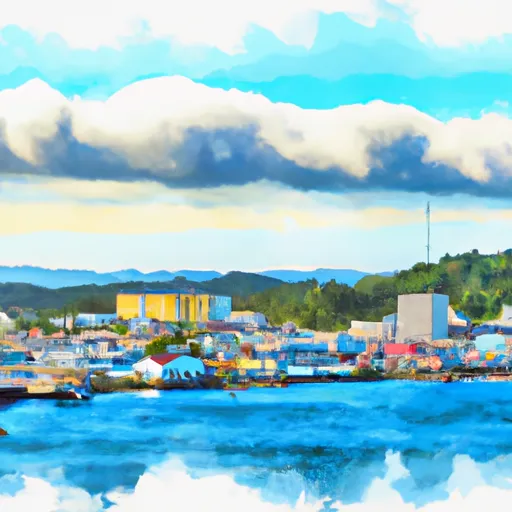-
 Snoflo Premium
Snoflo Premium
Get unlimited access to all our content
With no Ad interruptions! - Start Your Free Trial Login with existing account
Neah-Bay
Eden Index
Climate
5.2
•
Recreation
0.6
•
Community
1.3
•
Safeguard
2.6/10

Neah Bay is a small community located on the northwest corner of the Olympic Peninsula in Washington state. It is surrounded by stunning natural beauty and offers a unique climate and hydrology that adds to its charm.
The climate in Neah Bay is classified as a cool Mediterranean climate. Summers are mild with average temperatures ranging from the mid-60s to low 70s Fahrenheit, while winters are cool and wet, with temperatures in the 40s and significant rainfall. The area experiences a lot of fog due to its proximity to the Pacific Ocean.
Neah Bay is situated near the Strait of Juan de Fuca, which brings nutrient-rich waters from the Pacific Ocean. This leads to a diverse hydrology with abundant marine life, including salmon, halibut, and various shellfish. The area is also home to the Makah Indian Reservation, where the Makah Tribe relies on the ocean for sustenance and cultural practices.
Outdoor recreation opportunities in Neah Bay are plentiful. Fishing is a popular activity, both from the shore and on chartered boats. Visitors can also go kayaking, hiking, and camping in the nearby Olympic National Park, which offers stunning coastal views, old-growth forests, and diverse wildlife. The area is also known for its beautiful beaches, where visitors can enjoy beachcombing, birdwatching, and breathtaking sunsets.
What is the Eden Index?
The Snoflo Eden Index serves as a comprehensive rating system for regions, evaluating their desirability through a holistic assessment of climate health, outdoor recreation opportunities, and natural disaster risk, acknowledging the profound impact of these factors on livability and well-being.
Climate Health Indicator (CHI): 5.2
Neah-Bay receives approximately
2835mm of rain per year,
with humidity levels near 82%
and air temperatures averaging around
10°C.
Neah-Bay has a plant hardyness factor of
9, meaning
plants and agriculture in this region tend to thrive here all year round.
By considering the ideal temperature range, reliable water supplies, clean air, and stable seasonal rain or snowpacks, the Climate Health Indicator (CHI) underscores the significance of a healthy climate as the foundation for quality living.
A healthy climate is paramount for ensuring a high quality of life and livability in a region, fostering both physical well-being and environmental harmony. This can be characterized by ideal temperatures, reliable access to water supplies, clean air, and consistent seasonal rain or snowpacks.
Weather Forecast
Streamflow Conditions
Washington Coastal
Area Rivers
Washington Coastal
Snowpack Depths
Washington Coastal
Reservoir Storage Capacity
Washington Coastal
Groundwater Levels
Recreational Opportunity Index (ROI): 0.6
The Recreational Opportunity Index (ROI) recognizes the value of outdoor recreational options, such as parks, hiking trails, camping sites, and fishing spots, while acknowledging that climate plays a pivotal role in ensuring the comfort and consistency of these experiences.
Access to outdoor recreational opportunities, encompassing activities such as parks, hiking, camping, and fishing, is crucial for overall well-being, and the climate plays a pivotal role in enabling and enhancing these experiences, ensuring that individuals can engage in nature-based activities comfortably and consistently.
Camping Areas
| Campground | Campsites | Reservations | Toilets | Showers | Elevation |
|---|---|---|---|---|---|
| Ozette - Olympic National Park | 15 | 30 ft |
Catastrophe Safeguard Index (CSI):
The Catastrophe Safeguard Index (CSI) recognizes that natural disaster risk, encompassing floods, fires, hurricanes, and tornadoes, can drastically affect safety and the overall appeal of an area.
The level of natural disaster risk in a region significantly affects safety and the overall livability, with climate change amplifying these risks by potentially increasing the frequency and intensity of events like floods, fires, hurricanes, and tornadoes, thereby posing substantial challenges to community resilience and well-being.
Community Resilience Indicator (CRI): 1.3
The Community Resilience Indicator (CRI) recognizes that education, healthcare, and socioeconomics are crucial to the well-being of a region. The CRI acknowledges the profound impact of these elements on residents' overall quality of life. By evaluating educational resources, healthcare accessibility, and economic inclusivity, the index captures the essential aspects that contribute to a thriving community, fostering resident satisfaction, equity, and social cohesion.

